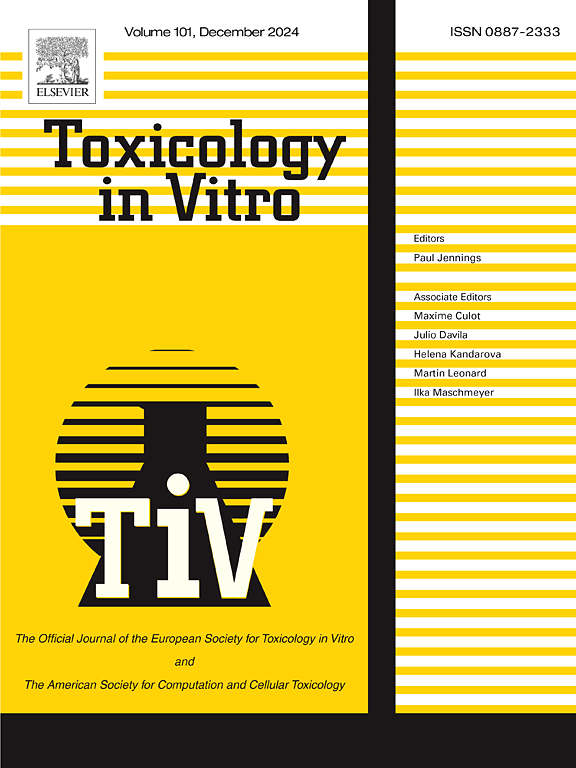Effect of curcumin on the embryotoxic effect of ethanol in a zebrafish model
IF 2.6
3区 医学
Q3 TOXICOLOGY
引用次数: 0
Abstract
Curcumin, a natural polyphenol found in the turmeric plant, has been shown to have anti-inflammatory and antioxidant properties. It has been widely studied for its potential protective effect against various health conditions, including ethanol-induced malformation.
Ethanol exposure during pregnancy can lead to various developmental abnormalities, known as fetal alcohol syndrome (FAS) and fetal alcohol spectrum disorders (FASD). Due to the high prevalence of FASD and FAS and no effective treatment, it is essential to develop preventive strategies. Recent studies have investigated the potential protective effect of curcumin against ethanol-induced malformation in animal models.
This study aimed to examine whether curcumin can reduce the toxic effects of ethanol in zebrafish embryos. The present study showed that pure curcumin applied together with 1.5 % ethanol (v/v) did not lead to a protective effect on ethanol-induced malformations such as disturbances of body length and width or pericardia oedema in growing zebrafish embryos. Moreover, curcumin extract showed a pro-oxidant effect in the Fenton reaction in the presence of ethanol.
姜黄素对斑马鱼模型中乙醇胚胎毒性效应的影响
姜黄素是一种存在于姜黄植物中的天然多酚,已被证明具有抗炎和抗氧化特性。姜黄素因其对各种健康状况(包括乙醇诱发的畸形)的潜在保护作用而被广泛研究。怀孕期间接触乙醇会导致各种发育异常,即胎儿酒精综合症(FAS)和胎儿酒精谱系障碍(FASD)。由于 FASD 和 FAS 的发病率很高,且没有有效的治疗方法,因此制定预防策略至关重要。最近的研究调查了姜黄素在动物模型中对乙醇引起的畸形的潜在保护作用。本研究旨在探讨姜黄素能否减轻乙醇对斑马鱼胚胎的毒性作用。本研究表明,纯姜黄素与 1.5 % 乙醇(v/v)一起使用不会对乙醇诱发的畸形(如生长中的斑马鱼胚胎体长和体宽紊乱或心包水肿)产生保护作用。此外,姜黄素提取物在乙醇存在下的芬顿反应中显示出促氧化作用。
本文章由计算机程序翻译,如有差异,请以英文原文为准。
求助全文
约1分钟内获得全文
求助全文
来源期刊

Toxicology in Vitro
医学-毒理学
CiteScore
6.50
自引率
3.10%
发文量
181
审稿时长
65 days
期刊介绍:
Toxicology in Vitro publishes original research papers and reviews on the application and use of in vitro systems for assessing or predicting the toxic effects of chemicals and elucidating their mechanisms of action. These in vitro techniques include utilizing cell or tissue cultures, isolated cells, tissue slices, subcellular fractions, transgenic cell cultures, and cells from transgenic organisms, as well as in silico modelling. The Journal will focus on investigations that involve the development and validation of new in vitro methods, e.g. for prediction of toxic effects based on traditional and in silico modelling; on the use of methods in high-throughput toxicology and pharmacology; elucidation of mechanisms of toxic action; the application of genomics, transcriptomics and proteomics in toxicology, as well as on comparative studies that characterise the relationship between in vitro and in vivo findings. The Journal strongly encourages the submission of manuscripts that focus on the development of in vitro methods, their practical applications and regulatory use (e.g. in the areas of food components cosmetics, pharmaceuticals, pesticides, and industrial chemicals). Toxicology in Vitro discourages papers that record reporting on toxicological effects from materials, such as plant extracts or herbal medicines, that have not been chemically characterized.
 求助内容:
求助内容: 应助结果提醒方式:
应助结果提醒方式:


